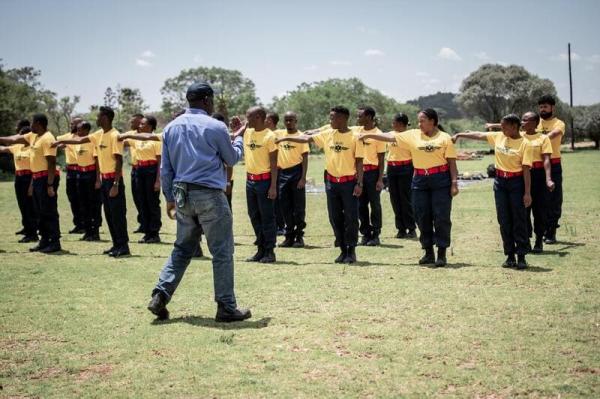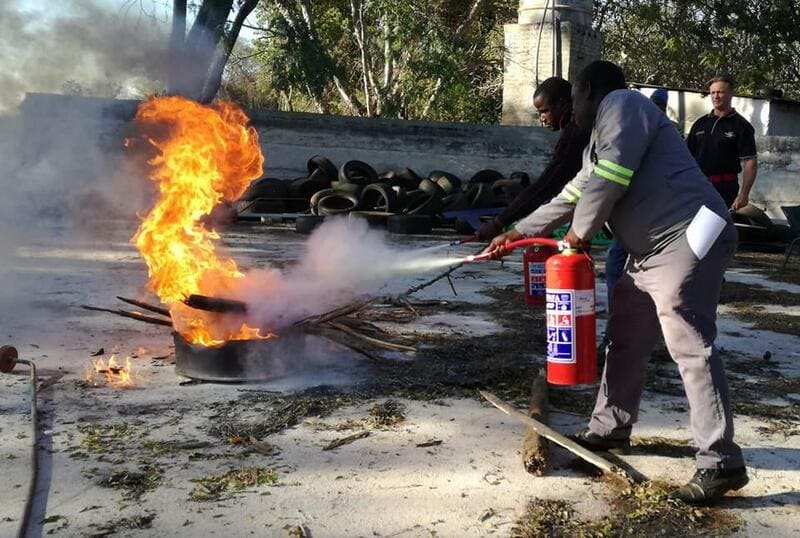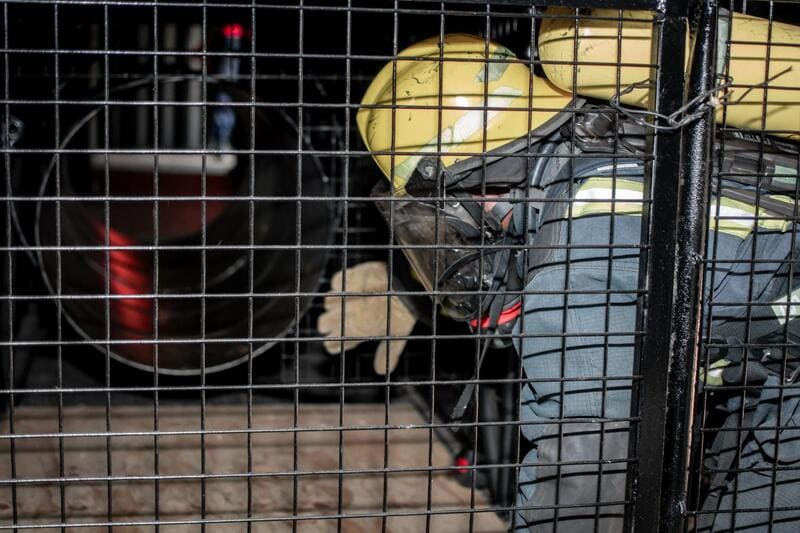Blog Post
Fire Fighting Course: The Different Courses Offered By EMCARE

A fire fighting course is an important step in not only training professional firefighters, but more accessible courses are helpful in providing valuable lifesaving information to the wide populace. In the same way that anyone can learn first aid treatment and be of assistance in a medical emergency situation, there are also introductory fire fighting training programs. These courses can teach you how to be of assistance in fire based emergencies, well waiting for professional help to arrive.
Fires can happen anywhere and at any time. From electrical fires, to shack fires and even wildfires in South African forests, all of them can be dangerous and more often than you may expect leads to deaths and damage of property. At EMCARE we are highly aware of the threat fires can pose to our South African population and that is why we believe in helping to educate a wider audience how to better combat the flames. Not only will those trained be better equipped to prevent fires from happening, but also be able to help their surrounding communities.
In this article we want to help inform our readers about what fire fighting courses we at EMCARE offer. As you will see our course material is broad and helps those of any skill level. From introductory courses meant for those who have never been trained in fire fighting before, to intermediate courses, and even more professional courses for those looking to pursue a career in fire fighting. Let's discuss these courses in more detail below.
Fire Fighting Course 1: Basic Fire Fighting Awareness (BFA)
One unexpected area where fires break out quite frequently, can cause major damage if not addressed quickly, are homes and office spaces. In South Africa there is even greater risk of home fires due to a large proportion of the population living in informal settlements called shacks, that are generally made from materials like cheap wood, or even cardboard which burn easily.
That is why we at EMCARE offer our basic fire fighting awareness course which will help train participants how to both manage small fires that break out at home or in the office. Students will even be taught the correct procedure on how to extinguish certain small fires as well. This course was designed to be presented to people, who may have a busy work schedule, as it only takes a half a day to complete and is valid for two years.
Course Content:
This introductory level fire fighting course covers many of the beginner essentials when it comes to
fire
fighting. One of the first modules covered in the course is called fire introduction. Here you will be
introduced to the theory behind fires, how they start, the different types of fires and how they burn.
In this course you will also be introduced to a variety of personal protection equipment (PPE) that one should have either at home or in an office in order to help prevent fires. You will also learn about different sorts of fire extinguishers available and the mediums they use to suppress fire. With both the PPE and fire extinguishers, you will learn how to both use them and take care of them so that they are available whenever you may need them.
The BFA course will also provide you with a module training you how to get yourself and others out of situations where a fire is out of control and also provide students with a practical fire fighting demonstration, in order to emphasise what was learnt in the module.
Fire Fighting Course 2: Basic Fire Fighting (Fire Marshal) (BFF)
A course that works well in tandem with the BFA course discussed above is the basic fire fighting course also referred to on our website as the fire marshal course. This course is a little longer than the BFA course as it takes a whole day to complete but is also valid for two years. This is because the BFF course provides a bit more in-depth training.
The BFF is designed to teach students how to prevent fires from occurring. This is done in several ways. The course will teach students how to prepare an environment so that it has the tools necessary to fight a fire if one occurs. It also helps students build confidence in case they are faced with a fire emergency. Let's review what you can expect to be taught in the course contents section below.
Course Modules:
In many ways the BFF fire fighting course incorporates what is taught in the introductory BFA course and
builds on to that by providing even more information. What is great about the BFF course is that you can
still participate even if you have not completed the BFA course previously as much of the information is
retaught here. So, you can rest assured that you are not missing a thing.
However, here let us look at the unique modules provided in the BFF course that are not covered in the BFA course. They include a module on teaching students how to provide an accurate and informative warning of an imminent fire emergency to those around them, whether that be at home or in a work environment. Furthermore, students will also be taught how to design a basic emergency plan, which can be extremely helpful in more effectively evacuating coworkers or family members, in the case of a fire.
In terms of practical application, the BFF course provides more theory on the different types of PPE equipment you may need to use, it also covers a wider range of fire extinguisher mediums, and most importantly has a module designed to teach students how to use hose and fire hydrant in order to suppress fires, which was not covered in the BFA course.

Fire Fighting Course 3: Intermediate Fire Fighting (IFF)
From the more basic courses discussed above, we now move onto the intermediate level. Unlike the BFF and BFA courses discussed above it is generally recommended that you have attended a basic fire fighting course in the past. However, this is not a strict pre-requisite and students are welcome to join even if they have not completed the courses discussed above. Due to the more complex nature of this course, it is carried out over two days, and again once completed is valid for two years.
The intermediate course looks to provide students with an even wider basis of knowledge than the introductory courses. Whereas basic fire fighting training covers essential basic fire theory and introduces participants to the different types of PPE and fire extinguishers one may use, the intermediate course takes it one step further by providing more practical knowledge on how to fight fires.
Course Modules:
The intermediate course will again cover much of what was taught in both the BFF and BFA modules. This
is to
help those who may not have completed any courses before to catch up and be on equal footing. From there
though the intermediate course expects participants to be involved in more practical training as well.
The practical application side of this fire fighting training involves two modules specifically these include the fire prevention principles and technique module as well as actual practical training with some of the most important fire suppression equipment around which includes fire extinguishers, a fire hose and hydrant drills.
Once you have completed this course you will have better practical knowledge on how to combat fires yourself, which can make all the difference in preventing loss of life or more extensive damage to property.
Fire Fighter Course 4: Fire Fighter I And Hazmat Awareness
From our beginner and intermediate courses that are designed to be all inclusive and provide helpful information to the broader public we now move on to our more professional fire fighting course. The following two courses discussed below are intended to be for those who wish to make fire fighting their professional career. Both fire fighter I and fire fighter II are accredited by the IFSAC and NFPA, these courses meet the standard for professional fire fighting qualifications.
In fire fighter I you will spend nine weeks not only learning about emergency response procedures and completing practical fire fighting drills but will also complete a program on hazmat awareness. Let us look at what this comprehensive course covers.
Course Modules:
It is important to note here, that unlike the other courses discussed in this article that only required
one
to be proficient in the English language, with both the fire fighter I and fire fighter II course there
are
a number of other important prerequisites that must be met before signing up. It is critical that you
visit
the overview page on our website to make sure you qualify.
Because these courses are designed by our EMCARE team to train professional firefighters, who will one day become first responders, the fire fighting course covers a much wider knowledge basis and is not just focused on the theory behind fires and how to fight them (although this is covered in depth as well). You will also be expected to learn about buildings and how they are constructed, South African legislation relevant to the fire fighting profession, how to command an emergency environment and how to work with other branches of first responders.
Your hazmat course will, which is a major proponent of the fire fighter I course, covers everything from a theoretical introduction to hazmat materials, properties of hazardous materials and how to effectively recognize these materials.
Both fire fighter courses I and II also require students to participate in many more practical drills in which you will be taught exactly how one should fight a fire in a team.

Fire Fighter Course 5: Fire Fighter II And Hazmat Operations
The final fire fighting course we want to highlight here briefly is the fire fighter II and hazmat operations course. This is a seven week course that builds on to what was covered in the fire fighter I course. Thus, it is also designed as a more complex course meant for those who are actively pursuing a career as a firefighter.
The major difference to the fire fighter I course already discussed is the hazmat operations segment. Whereas with the fire fighter I course where you are taught how to be aware of potentially hazardous materials, with fire fighter II you are taught how to actually deal with hazmat materials in specially designed hazmat procedure protocols.
EMCARE: The Home Of Fire Fighting Training
In this article we have looked to highlight a number of the most important fire fighting courses we at EMCARE offer. We offer training for everyone whether you are a beginner or looking to pursue fire fighting as a professional career. So, If you want to learn more about how you can get signed up and start your training, visit our website today.
GET IN TOUCH
There are a few ways to reach us below. Please feel free to contact us via phone, email or you can send us a message via the form provided and we will get back to you.




















